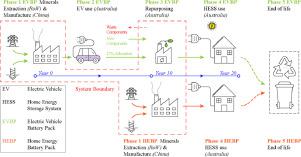Resources, Conservation and Recycling ( IF 11.2 ) Pub Date : 2021-07-01 , DOI: 10.1016/j.resconrec.2021.105759 Nicholas Wilson , Ella Meiklejohn , Brodrick Overton , Finlay Robinson , Shahjadi Hisan Farjana , Wen Li , Jo Staines

|
As the World's dependence on lithium battery technology continues its rapid growth, reserves of key manufacturing minerals are not forecast to keep pace with demand. Repurposed electric vehicle batteries offer a viable means to reduce the number of retired lithium-ion batteries proceeding directly to landfill and prolong their useful life while end of life solutions, including recycling, are developed and matured. This paper presents a novel physical allocation method based on the critical performance criteria: remaining capacity, module retention rate and repurposed electric vehicle battery lifetime (second life). To verify the allocation method, a case study directly compares the emissions generated by a repurposed electric vehicle battery and a virgin stationary storage battery of equivalent capacity in Australia. The repurposed battery has a smaller footprint across all eight environmental impact categories, provided it operates for a minimum of six years. A sensitivity analysis shows battery repurposing can achieve carbon reductions if the repurposed electric vehicle battery lifetime exceeds 4.25 years. The breakeven points for remaining capacity and module retention rate at the beginning of the second life occur at 66% and 75% respectively. In addition, a comprehensive repurposing life cycle inventory was developed for the repurposing phase which includes all added components and processes required to repurpose an electric vehicle battery to function as a stationary storage battery. Further analysis discusses the influence of increased production efficiencies over time when comparing product systems, and the need to account for these changes in allocation methodology.
中文翻译:

比较生命周期评估的物理分配方法:以澳大利亚电动汽车电池再利用为例
随着世界对锂电池技术的依赖持续快速增长,预计关键制造矿产的储量无法跟上需求的步伐。重新利用的电动汽车电池提供了一种可行的方法,可以减少直接进入垃圾填埋场的退役锂离子电池的数量并延长其使用寿命,同时开发和成熟包括回收在内的报废解决方案。本文提出了一种基于关键性能标准的新型物理分配方法:剩余容量、模块保留率和重新利用的电动汽车电池寿命(第二次寿命)。为了验证分配方法,一项案例研究直接比较了澳大利亚重新利用的电动汽车电池和同等容量的原始固定蓄电池产生的排放量。重新利用的电池在所有八个环境影响类别中的足迹更小,前提是它至少可以运行六年。一项敏感性分析表明,如果重新利用的电动汽车电池寿命超过 4.25 年,电池再利用可以实现碳减排。第二次生命开始时的剩余容量和组件保留率的盈亏平衡点分别出现在 66% 和 75%。此外,还为再利用阶段制定了全面的再利用生命周期清单,其中包括将电动汽车电池再利用为固定蓄电池所需的所有附加组件和流程。在比较产品系统时,进一步分析讨论了随着时间的推移提高生产效率的影响,









































 京公网安备 11010802027423号
京公网安备 11010802027423号